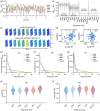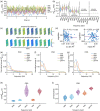Predicting time-resolved electrophysiological brain networks from structural eigenmodes
- PMID: 35642600
- PMCID: PMC9435022
- DOI: 10.1002/hbm.25967
Predicting time-resolved electrophysiological brain networks from structural eigenmodes
Abstract
How temporal modulations in functional interactions are shaped by the underlying anatomical connections remains an open question. Here, we analyse the role of structural eigenmodes, in the formation and dissolution of temporally evolving functional brain networks using resting-state magnetoencephalography and diffusion magnetic resonance imaging data at the individual subject level. Our results show that even at short timescales, phase and amplitude connectivity can partly be expressed by structural eigenmodes, but hardly by direct structural connections. Albeit a stronger relationship was found between structural eigenmodes and time-resolved amplitude connectivity. Time-resolved connectivity for both phase and amplitude was mostly characterised by a stationary process, superimposed with very brief periods that showed deviations from this stationary process. For these brief periods, dynamic network states were extracted that showed different expressions of eigenmodes. Furthermore, the eigenmode expression was related to overall cognitive performance and co-occurred with fluctuations in community structure of functional networks. These results implicate that ongoing time-resolved resting-state networks, even at short timescales, can to some extent be understood in terms of activation and deactivation of structural eigenmodes and that these eigenmodes play a role in the dynamic integration and segregation of information across the cortex, subserving cognitive functions.
Keywords: dynamic functional connectivity; eigenmodes; magnetoencephalography.
© 2022 The Authors. Human Brain Mapping published by Wiley Periodicals LLC.
Conflict of interest statement
There were no competing or conflicting interests for any of the authors.
Figures





Similar articles
-
Task- and stimulus-related cortical networks in language production: Exploring similarity of MEG- and fMRI-derived functional connectivity.Neuroimage. 2015 Oct 15;120:75-87. doi: 10.1016/j.neuroimage.2015.07.017. Epub 2015 Jul 11. Neuroimage. 2015. PMID: 26169324
-
How do spatially distinct frequency specific MEG networks emerge from one underlying structural connectome? The role of the structural eigenmodes.Neuroimage. 2019 Feb 1;186:211-220. doi: 10.1016/j.neuroimage.2018.10.079. Epub 2018 Nov 3. Neuroimage. 2019. PMID: 30399418
-
Mapping functional brain networks from the structural connectome: Relating the series expansion and eigenmode approaches.Neuroimage. 2020 Aug 1;216:116805. doi: 10.1016/j.neuroimage.2020.116805. Epub 2020 Apr 23. Neuroimage. 2020. PMID: 32335264
-
Cortical cores in network dynamics.Neuroimage. 2018 Oct 15;180(Pt B):370-382. doi: 10.1016/j.neuroimage.2017.09.063. Epub 2017 Sep 30. Neuroimage. 2018. PMID: 28974453 Review.
-
Mapping cognitive and emotional networks in neurosurgical patients using resting-state functional magnetic resonance imaging.Neurosurg Focus. 2020 Feb 1;48(2):E9. doi: 10.3171/2019.11.FOCUS19773. Neurosurg Focus. 2020. PMID: 32006946 Free PMC article. Review.
Cited by
-
Brain network communication: concepts, models and applications.Nat Rev Neurosci. 2023 Sep;24(9):557-574. doi: 10.1038/s41583-023-00718-5. Epub 2023 Jul 12. Nat Rev Neurosci. 2023. PMID: 37438433 Review.
-
Disruption in structural-functional network repertoire and time-resolved subcortical fronto-temporoparietal connectivity in disorders of consciousness.Elife. 2022 Aug 2;11:e77462. doi: 10.7554/eLife.77462. Elife. 2022. PMID: 35916363 Free PMC article.
-
Tau protein spreads through functionally connected neurons in Alzheimer's disease: a combined MEG/PET study.Brain. 2023 Oct 3;146(10):4040-4054. doi: 10.1093/brain/awad189. Brain. 2023. PMID: 37279597 Free PMC article.
-
Structure-function models of temporal, spatial, and spectral characteristics of non-invasive whole brain functional imaging.Front Neurosci. 2022 Aug 30;16:959557. doi: 10.3389/fnins.2022.959557. eCollection 2022. Front Neurosci. 2022. PMID: 36110093 Free PMC article. Review.
-
Dissociation between phase and power correlation networks in the human brain is driven by co-occurrent bursts.Commun Biol. 2023 Mar 18;6(1):286. doi: 10.1038/s42003-023-04648-x. Commun Biol. 2023. PMID: 36934153 Free PMC article.
References
-
- Andersson, C. A. , & Bro, R. (2000). The N‐way toolbox for MATLAB. Chemometrics and Intelligent Laboratory Systems, 52, 1–4.
Publication types
MeSH terms
LinkOut - more resources
Full Text Sources

